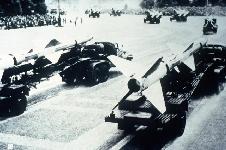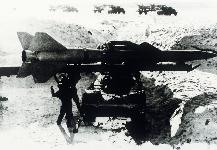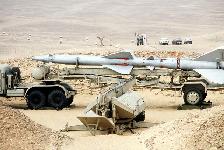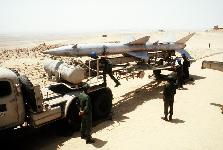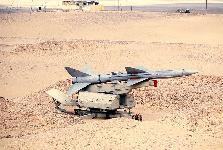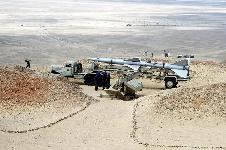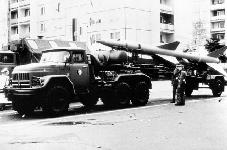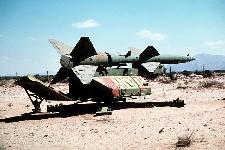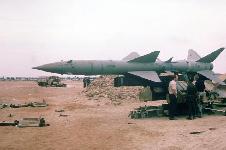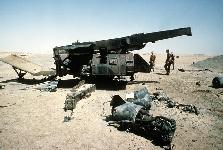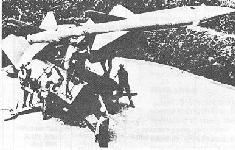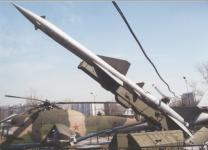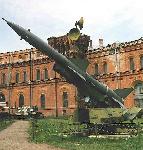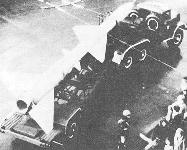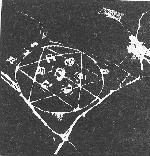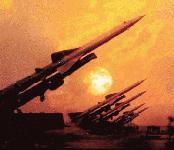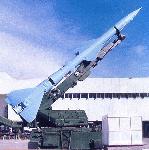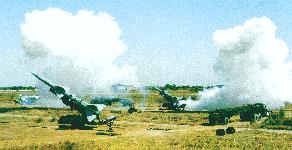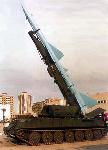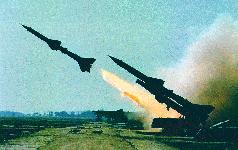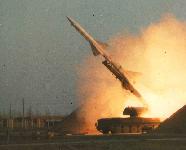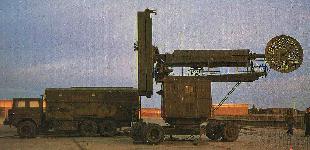




 The V-75 (SA-2) surface-to-air missile system was designed for the defense of both fixed targets and field forces. The V-75 was designed to cope with the threat posed by small groups of aircraft rather than massed raids. Flexibility and mobility are its chief advantages over the SA-1. In contrast to the massive SA-1 sites, each of which is capable of defending only a limited sector around the target area, each SA-2 site is capable of 360� coverage. This flexibility is obtained at the expense of target handling capacity and rate of fire relative to the SA-1.
The V-75 (SA-2) surface-to-air missile system was designed for the defense of both fixed targets and field forces. The V-75 was designed to cope with the threat posed by small groups of aircraft rather than massed raids. Flexibility and mobility are its chief advantages over the SA-1. In contrast to the massive SA-1 sites, each of which is capable of defending only a limited sector around the target area, each SA-2 site is capable of 360� coverage. This flexibility is obtained at the expense of target handling capacity and rate of fire relative to the SA-1.
Although there are a variety of arrangement patterns, all sites consist of six launching positions -- usually revetted - deployed around a guidance radar and linked by service roads to facilitate loading. While the sites were permanent installations, all operating components of the system are mounted on wheeled vehicles and are capable of movement by road or raiL
The V-75 was the basic missile defense system for critical urban-industrial areas in the USSR, other than Moscow. The V-75 deployment began on a wide scale since early 1958, with sites located throughout the western part of the Soviet Union and Warsaw Pact countries. Deployment patterns and levels of concentration varied according to the geography, size, and shape of the target area, and the Soviet estimate of the worth of individual targets. Between mid-1958 and 1964 more than 600 SA-2 sites were identified by US intelligence in the USSR, mostly in defense of population centers, industrial complexes, and government control centers. Most SA-2 sites defended major centers of population and industry. SA-2 defenses were also deployed for the special protection of nuclear materials production and storage facilities. In addition, some key Soviet field forces and long range bomber bases were included in the SA-2 deployment pattern. The construction of sites and the training and activation of firing units was seasonal, with activity at a minimum during the winter months. The sites in the Moscow area, located within the inner ring of SA-1 sites, were intended to supplement the existing defenses. Deployment of SA-2 installations around Moscow included seven sites as of 1964 as part of a program to supplement the SA-1 system.Missile defenses were provided for most of the Soviet cities with populations greater than 200,000. SA-2 sites were emplaced at some smaller urban areas which contained government control centers or other installations of critical importance. They were also deployed for defense of naval and port facilities, nuclear production and weapon storage Installations, missile test ranges, and Industrial facilities. Other major military installations, such as long-range missile sites and alrfields of the long-range air force, are also defended by SA-2. A number of sites in border areas, which were unrelated to specific targets, were part of the deployment of peripheral defenses which eventually extended from the Kola Peninsula along the western and southern borders of the USSR into central Asia. Deployment in the Baltic coastal area was particularly dense. In mid-1962 about 750 sites were operational in defense of more than 200 target areas in the USSR. The Soviets eventually deployed roughly a thousand SA-2 sites in the USSR, with the major portion of the deployment completed by the mid-1960s.
Some SA-2 units were deployed in support of Soviet field forces in East Germany and in the USSR. Although SA-2 units assigned to Soviet field forces were normally emplaced at fixed installations, the system is transportable by road and SA-2 units were observed in field exercises. However, SA-2 units have a limited ability to follow a fast moving front because of the requirement for good roads and the time required to displace to new positions. SA-2 missile defenses for field forces were primarily assigned to such targets as major headquarters, logistic centers, and airfields.
Deployment of SA-2 sites for defense of Warsaw Pact targets began in 1960. The heaviest deployment has occurred in East Germany. About half of the sites were manned by East German troops, and the remainder by units of the Soviet field forces. The East German sites were located in the vicinity of Berlin and in the northern portion of East Germany. The Soviet sites were deployed to defend important Soviet military installations such as major headquarters and airfields.
Suspension of Soviet assistance limited the extent of SA-2 deployment in China. Only about a half dozen sites were initially deployed in China, three of them at Beijing. These sites contained Soviet manufactured equipment. The Chinese license-built version of the V-75 was designated the HQ-1. The People's Republic of China developed its own modified version of the V-750 under the designation HQ-2 (Hong Qian = Red Leader), with the Western designation CSA-1.
According to a China sales brochure, the FT-2000A SAM will use a highly-modified HQ-2/ CSA-1 missile that has been equipped with a passive radio frequency homing seeker operating in the 2- to 6-GHz band. The FT-2000A also will contain a new millimeter-wave band fuze, a new guidance-and-control section, and a new 60 kg fragmentation warhead. The missile has a cutoff valve for thrust adjustment while in flight, probably to extend its range. The missile seeker is loaded with the target aircraft�s radio frequency (RF) signature before launch and relies on this information for tracking and intercept. The missile has an estimated maximum range of 60 km, with a maximum altitude of 18,000 meters.
A stand-alone FT-2000A battery consists of a central control station and twelve launchers, each holding one missile. The central control station has one master passive sensor and three auxiliary passive sensors. The auxiliary passive sensors coordinate with the master passive sensor through triangulation to determine angle and range of targets emitting in the 2- to 6-GHz band. This configuration is totally passive, relying on the RF emissions of the target.
A composite fire unit consists of FT-2000A launchers and missiles, integrated with standard SAM components like those of the HQ-2, SA-2, or SA-3. Although a special fire control unit and launcher are required, this configuration allows anti-jamming missiles to replace several of the command guided missiles normally associated with these SAMs.
Egyptian technicians have reverse engineered and modified two Soviet SAMs -- the Ayn as Saqr (a version of the SA-7) and the Tayir as Sabah (a version of the SA-2).
The V-75 SA-2 GUIDELINE is a medium to high altitude surface-to-air missile system. This two-stage missile has a large solid propellant booster stage fitted with four very large delta fins. The core stage consists of a storable liquid propellant sustainer rocket motor using inhibited red fuming nitric acid oxidizer and kerosene fuel. A set of four cropped delta-shaped wings are located near the mid-section, with a second in-line set of smaller fixed fins at the nose, and a third in-line set of slightly larger powered control fins at the tail.
The guidance system at an SA-2 site can handle only one target at a time, but can direct three missiles against a target simultaneously. Additional missiles could be fired against the same target after one or more missiles of the first salvo had completed their run. The Soviets apparently believed they must program three or four missiles against each target in order to achieve acceptable kill probabilities.
The 295 kg nuclear warhead used only on the SA-2E variant is believed to have a yield of 15 kT. The other V-75 variants have an internally grooved fragmentation warhead weighs 195 kg (130 kg of which is high explosive) with proximity, contact and command fusing available. This conventional warhead is fitted forward of the main fins and behind the nose-mounted guidance assembly. At medium and low altitudes the kill radius is about 65 meters and the blast radius for severe damage is 100-120 meters. The maximum blast radius against a high altitude target is approximately 250 meters, due to the rarefied atmosphere. The weapon has a accuracy of 75 meters with the large blast radius compensating for system inaccuracies.
The V-75 system is designed to be simple and easy to operate with the minimum of specialized training. The standard deployment pattern of a battalion site consists of six semi-fixed trainable single rail launchers are deployed in the familiar hexagon arrangement about 60-100 meters apart. The launchers may be dug into pits, left at ground level or hardened in concrete revetments. The battery command post fire control team and its computer, the Fan Song missile control radar, the P-12 Spoon Rest early warning radar, and typically six reload rounds on their articulated trailers are all located in the center of the launchers array.
The Spoon Rest A-band warning and target acquisition radar has a range of 275 km using a large Yagi antenna array.
The maximum radar range of the E-band Fan Song A/B/F radar varies between 60-120 km depending upon target type, altitude and operating conditions. The G-band Fan Song D/E maximum range is extended to between 75-145 km under equivalent conditions.
| SIDE NET | PRV-11 |
| Function | Height |
| Range | 28 km |
Frequency | E-band |
Associated weapon system | SA-2/3/5 |
Recognition 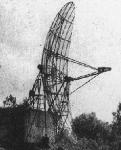
|
At regimental HQ there is a fourth Spoon Rest, a van-mounted P-15 Flat Face 250 km range C-band search and tracking radar with two elliptical parabolic reflectors and a PRV-11 Side Net 180 km range E-band nodding height-finder radar mounted on a box-bodied trailer. There is also a radar control truck and a Mercury Grass truck-mounted command communications system for linking the HQ to the three battalions.
Some countries which deploy early versions of the V-75 use the older ground-mounted P-8 Dolphin Knife Rest-A truck-mounted P-10 Knife Rest-B/C radars instead of the Spoon Rest. These A-band radars have an operating range of about 150-200 km.
The People's Republic of China has deployed a modified version of the V-75 under the designation HQ-2. The license-built version was the HQ-1.
Specifications |
|
|
DOI |
1959 |
|
Status |
Standard |
|
Length (m) |
10.60 |
|
Diameter (m) |
.70 |
|
Weight at launch (kg) |
2,300 |
|
Propulsion system |
|
|
Booster |
Solid |
|
Sustainer |
Liquid |
|
Launch rails/tubes |
Single rail, ground mounted (not mobile) |
|
Guidance |
Command |
|
Warhead (type) |
HE 200kg (295kg SA-2E) 188kg (HQ-2B/F/J/P), |
|
Performance: |
|
|
Max. velocity (Mach) |
4.0 B/C/D, 4.5 E/F Mach |
|
Effective altitude |
27 B/C/F & HQ-2B/F/J/P, 40 D/E km |
|
Maximum range (km) |
35km B/F, 44km C, 50km D/E |
|
Minimum range (km) |
7-9 |
|
Kill Radius |
65 m |
|
Reload time (min) |
10 |
|
Associated radars |
FAN SONG, SPOON REST |
